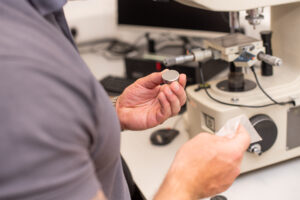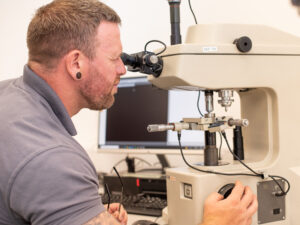Microhardness & Microhardness Testing
Microhardness & Microhardness Testing

Microhardness Testing at Aerofin Laboratories
Microhardness refers to the measurement of hardness on a microscopic level. It’s a valuable technique in materials science and engineering to understand the mechanical properties of materials, especially thin coatings or surface layers. When discussing the microhardness of a coating on a mounted cross-section, we are referring to the hardness of a thin layer of material that has been applied on top of a substrate and then prepared for examination under a microscope.
When evaluating the microhardness of a coating on a mounted cross-section, several factors come into play:
- Coating Thickness: The thickness of the coating is important, most commonly in ensuring there is enough coating to be able to conduct the test to obtain reliable results.
- Indenter Type: The type of indenter used can vary, with common types being Vickers and Knoop indenters. These indenters produce different shaped impressions, which can affect how hardness is measured in different materials.
- Load Applied: The load applied during the indentation process determines the size of the indentation and can affect the measured hardness. Lighter loads are typically used for thin coatings to avoid damaging the substrate.
- Substrate Material: The material beneath the coating (the substrate) can influence the hardness measurement due to interactions between the coating and substrate.
- Microstructure: The microstructure of both the coating and substrate can affect the measured microhardness. Different phases or grain structures can result in varying hardness values.
- Preparation: The preparation of the mounted cross-section is crucial. Careful cutting, mounting, grinding, and polishing are necessary to expose the coating and provide a smooth, flat surface for accurate indentation.

Microhardness testing at Aerofin Laboratories / Lab Technician inspecting the sample.
Microhardness Testing
Microhardness testing involves indenting the surface of a material with a small indenter under a specific load. The size of the indentation is then measured, and this measurement is correlated with the hardness of the material. Microhardness testing is particularly useful when dealing with small and delicate samples, thin coatings, or areas where traditional macroscopic hardness testing might not be practical.
Microhardness Testing on a coated cross-section can provide insights into the mechanical properties and potential performance of coatings in real-world applications. It’s often used in quality control and research to ensure that coatings meet specific hardness requirements and will perform as intended in various conditions.
Microhardness Testing is frequently used to assess the properties of coatings or thin layers of materials at lighter loads compared to macro hardness tests such as Brinell, Rockwell and Vickers.
Aerofin Labs utilise microhardness testing to assess a material or coatings suitability for function in service e.g. chrome, nickel and hard anodise where impact and wear resistance (rotational and reciprocal) are important.
Micro-hardness testing can also be used to determine:
- Surface hardening.
- Case hardening depth.
- Hardness of fragile or brittle materials.
- Microstructure hardness variations.


